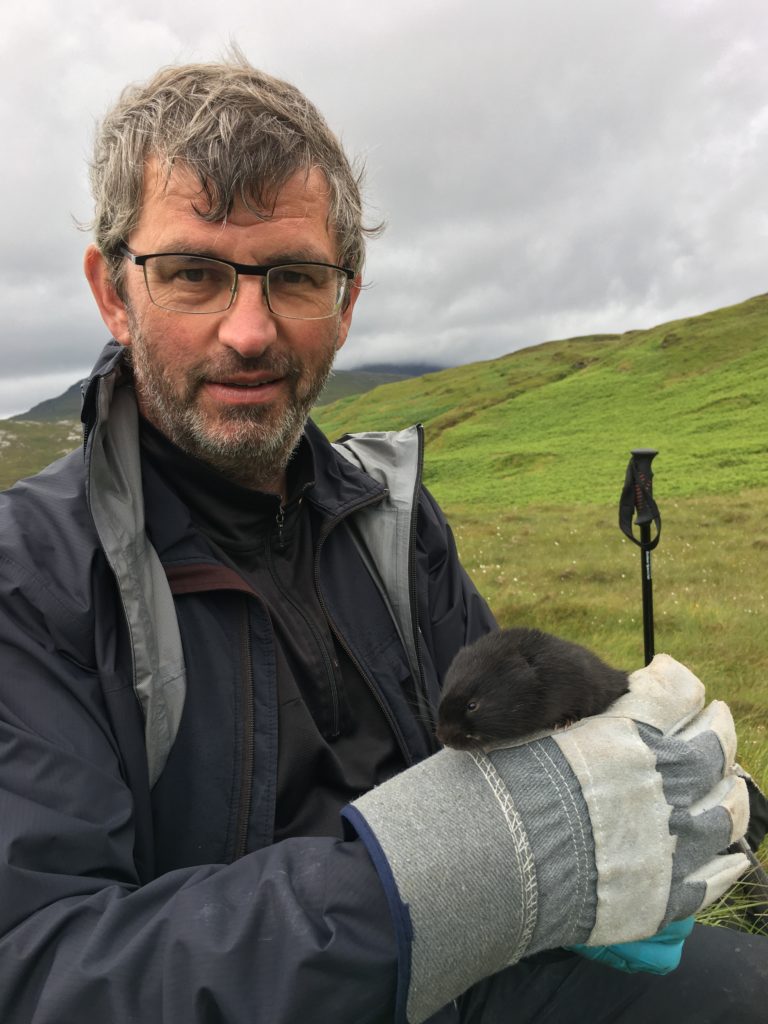Building the complexity of species interactions into conservation policy and practice.
Professor Xavier Lambin’s research uses population ecology to solve pressing applied issues in wildlife management and conservation – such as the impact of invasive non-native species – through long-term, large-scale field studies and using state of the art statistical techniques to link theoretical and empirical studies.
“My work on predation with multiple collaborators has shown that introduced American mink drive native water vole metapopulations to extinction, slowly but steadily,” he says. “Fortunately, invasive mink control implemented over large spatial scales by suitably supported citizen conservationists can effectively turn the tide.
“In fact, the newly predator-enriched communities that emerge from conservation efforts result in many novel interactions, some with surprising outcomes. For instance, working with collaborators, we have shown that recovering native pine martens act as efficient biological control agents against invasive grey squirrels and may save the day here. However, marten predation might also contribute to the decline of native capercaillie, but once this is understood, it can be mitigated with smart conservation interventions.
“And, using 40 years of data, we showed that recovering goshawk populations prey upon nearly all bird species including other raptor species. Changing predation levels will result in some winners and some losers – we have so much more to learn.
“I am convinced that long-term studies are uniquely crucial for deciphering the influence of global trends such as climate and land-use change, and as platforms for multidisciplinary studies. Accordingly, I am invested in the long term empirical study of population cycles in field voles, owls and other raptors started in Kielder Forest by the Forestry Commission’s Steve Petty as long ago as 1983. In fact, I have vowed to continue it for as long as I am able. And twenty-four years ago I initiated my own long-term surveys of water voles in Scotland’ eastern uplands (where invasive mink have been pushed back) and in Assynt, an important mink-free conservation reference point. Countless students have contributed to this work and gained valuable experience along the way.
Childhood dream to global conservation research hub
“I have had a passion for nature in all its forms for as long as I can recollect, and this is thanks both to my father – who took me in the evenings to listen to the curlews and geese coming to roost on the salt marshes of Belgium’s over-developed coastline – and to my mother who drove me on countless Saturday mornings to join birdwatching rambles with an inspiring primary school teacher. Fifty years later, I am privileged to continue living my childhood dream of being an ecologist seeking to understand the complexities of the natural world.

“I arrived in Scotland 30 years ago on a short contract to work on nepotism in red grouse – and asking, ‘why the rich get richer and the poor poorer,’ and how this can cause instability in populations. Even if UK politics sometimes make me think grouse and human societies have similar features, I, like many others, found wonderful opportunities in Scotland. Indeed, many of my current international projects with colleagues in Chile, Argentina, Spain, Poland or Norway take place with friends who spent time as researchers in one of Scotland’s ecological research institutes or universities.”
Education for all
“I have been privileged to have been encouraged by outstanding mentors including Rolf Ims (University of Tromsø), Dennis Chitty and Charles Krebs (University of British Columbia) and Robert Moss (Institute of Terrestrial Ecology) in Scotland. It thus feels natural that it is now my turn give back to the many students of all levels and skills who want to learn about ecology and make a difference in the world they inherit. There is nothing that gives me more satisfaction than seeing young, passionate individuals blossoming in gaining the skills that they need to fulfil their dreams. I feel immensely lucky to have had the opportunity to mentor so many talented students who are making a difference in many countries and across professions.”
Professor Xavier Lambin is Professor of Ecology at the University of Aberdeen, a Fellow of the Royal Society of Edinburgh and the Royal Society of Biology. His research is supported by NatureScot, NERC, the National Lottery Heritage Fund, Forestry and Land Scotland and Wildland Limited, among others. To find out more, check here. He is part of the Scottish Invasive Species Initiative, the Cairngorms Connect Predator Project, and also works on the CONTAIN programme to tackle invasive species in Latin America
This post is part of a series showcasing Scotland’s innovative, high-impact research supporting biodiversity conservation, in partnership with Scottish Government and NatureScot. Read the rest of the series here.
Further reading
Melero Y., et al. 2018. Ecological traps for large-scale invasive species control: Predicting settling rules by recolonising American mink post-culling. Journal of Applied Ecology 55(4): 769—1779. https://doi.org/10.1111/1365-2664.13115
Sheehy, E., et al. 2018. The enemy of my enemy is my friend: Native pine marten recovery reverses the decline of the red squirrel by suppressing grey squirrel populations. Proc. R. Soc. B Biol. Sci. 285: 20172603. https://doi.org/10.1098/rspb.2017.2603
Lambin, X., et al. 2020. CONTAIN: Optimising the long term management of invasive alien species using adaptive management. NeoBiota 59: 119—138. https://doi.org/10.3897/neobiota.59.52022
Twining, J.P., et al. 2022. Restoring vertebrate predator populations can provide landscape-scale biological control of established invasive vertebrates: Insights from pine marten recovery in Europe. Global Change Biology 28: 5368—5384. https://doi.org/10.1111/gcb.16236
Hoy S.R., et al. 2017. Density-dependent increase in superpredation linked to food limitation in a recovering population of northern goshawks, Accipiter gentilis. Journal of Avian Biology 48(9): 1205—1215. https://doi.org/10.1111/jav.01387
